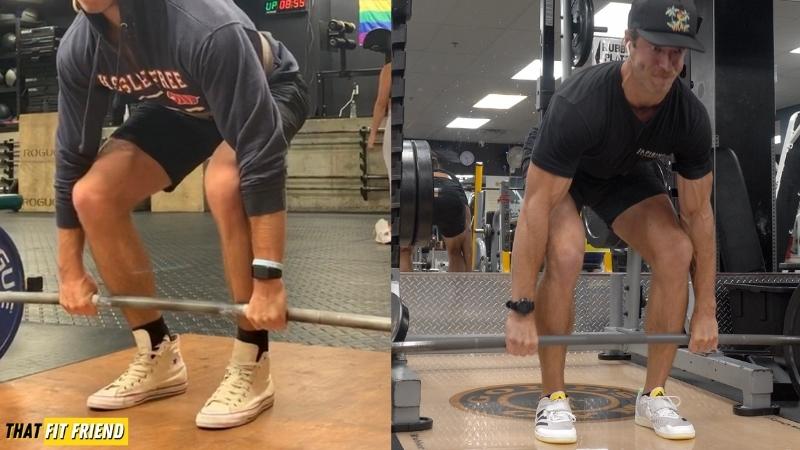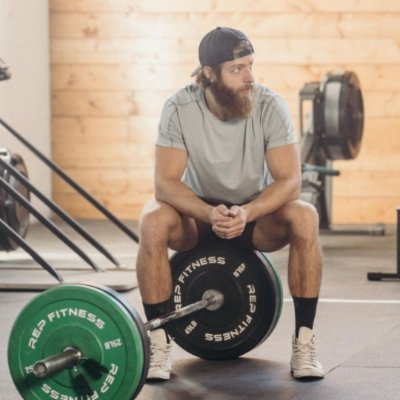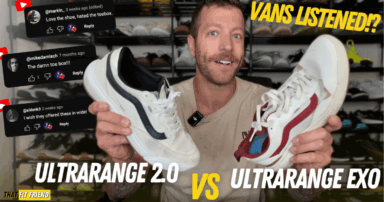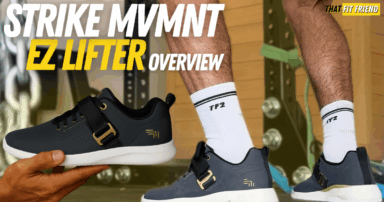That Fit Friend is supported by its readers. I [Jake Boly] run this site myself and buy the gear I review. If you purchase through my site, I may earn commissions on sales, read more here!
Table of Contents+
It can be both a fun and daunting task when looking for the best shoes for powerlifting. Ideally, you’ll want shoes for powerlifting that feed well into your movement mechanics and align with your specific wants and needs.
For example, some athletes squat in weightlifting shoes, while others opt for flat shoes or shoes with a minimal drop. If you can understand which shoes you prefer, you can make more educated decisions on the shoes for powerlifting you’ll resonate best with.
In general, you’ll want to pay close attention to the shoes you use for deadlifts and squats. Your shoes for bench press can also be very important, but squats and deadlifts will often take precedence when it comes to your footwear’s importance in competition.
In this article, I’m going to cover a range of some of the best shoes for powerlifting based on what you’re looking for. Do you want weightlifting shoes or flats? I cover all of this below.

Best Flat Powerlifting Shoes for Squats
I consider two key performance areas when testing the best flat powerlifting shoes for squats. First, I assess a shoe’s overall stability. Is it stable enough to support heavy training and competition squats?
Second, I’m ensuring that the shoe is flat and has a zero-drop construction. For powerlifters that want flat shoes, especially for squats, they’ll want to make sure that their shoes are dialed into their specific squat needs. I have two picks here since this is a big category.
Top-Pick: AVANCUS Apex Power
The AVANCUS Apex Power is a model that I’d call a “premier” powerlifting shoe, as in, that’s why you buy this shoe. It’s built specifically for powerlifters and some of the strongest athletes helped them develop it.
- Best For: Maximizing grip in squat, bench press, and deadlift.
- Heel-to-Toe Drop: 0mm
- Removable Insole: Yes
- Weight: 11.45 ounces (size 10 model)
- Sizing: True to size for most
- For More Info: Read My Review

All of the Apex Power models have been solid, so whether you get the latest or find an older model on sale, I think you’ll be well off with these shoes. They’re built to be a minimalist option for powerlifting so their stack height is well under 7mm for maximal ground feel in squats and deadlifts.
They also have a special made Viziun outsole tread built specifically to give you maximal bite when pulling sumo or squatting and grounding the feet. This tread wraps around the shoe as well which is nice for giving you additional structure when driving into the sidewalls of this shoe. I’ve pulled well over 455 lbs in these shoes conventional and sumo and have enjoyed their performance.

Their width is also a perk to them. These have a fairly wide midfoot and there isn’t a super aggressive taper. If you love more room for toe splay and have a wide, flat foot, then you’ll really resonate with the fit of these. For maximal grip and ground feel, yo can’t go wrong with the AVANCUS Apex Power shoes.
Runner-Up: Adidas The Total
The Adidas “The Total” is taking my top pick as the best flat powerlifting shoe for squats. There’s a lot to like about this model, and to be quite honest, I feel like it doesn’t receive the attention it should when it comes to its performance.
- Best For: Powerlifting, Squats, and Recreational Lifters
- Heel-to-Toe Drop: 0mm
- Weight: 12.1 oz
- Removable Insole: Yes
- Sizing: Size Down a Half Size (my full sizing thoughts in the review below)
- For More Info: Read My Review

The Total is a shoe that was purposely built for strength training by a strength coach and it delivers a lot of powerlifting-friendly shoes asks. For example, this model features a midfoot strap for additional support in squats and deadlifts.
In addition, The Total features a wide toe box to promote full toe splay when squatting and deadlifting, so all types of foot anatomies should align with this shoe, and its outsole grips wooden platforms, rubber gym floors, and competition carpets well.

What I like most about Adidas The Total is that while it is flat and stable, it’s not a true minimalist shoe so it works well for a wide range of lifters. If you don’t want a pair of barefoot shoes for squats, but want a shoe that’s flat and optimized for squats, The Total is a good pick.
Best Heel-Elevated Shoes for Powerlifting
To rank the best heel-elevated (AKA weightlifting shoes) shoes for powerlifting, I primarily consider two key construction areas. First, does the shoe grip the floor well? You’ll want a pair of lifting shoes that can grip wooden platforms, rubber gym floors, and carpets used in competition well.
Second, does the shoe provide a nice stable base with adequate midfoot support? Since powerlifters will only need their weightlifting shoes for squats and accessories here and there, you’ll want to find shoes that really lock and anchor the feet down.
Top Pick: Reebok Legacy Lifter III
The Reebok Legacy Lifter III is my top pick as the best pair of lifting shoes for powerlifting. In the context of powerlifting specifically, there are three things that I enjoy with the Legacy Lifter III.
- Best For: Squats, Recreational Lifting, and Weightlifting (heavier model, FYI)
- Effective Heel Height: 22mm/.86″
- Weight: 23.1 oz (for my size 10 model)
- Removable Insole: Yes
- Sizing: True to size (neutral width)
- For More Info: Read My Review

First, this model’s stability is really solid. This shoe features a firm TPU heel with a rigid rubber outsole. The combination of both of these construction characteristics gives you a nice “anchored” feeling when squatting.
Second and on top of feeling anchored in this shoe, the Reebok Legacy Lifter III does have a heavier build to it. For weightlifting, this can be hit or miss as heavier shoes can slow down foot turnover, but for squat-focused training, I enjoy this for security.

Third and lastly, the midfoot support is solid in the Legacy Lifter III. The thicker midfoot strap and Reebok Pump System make it easy to adjust the security that you get with this shoe. If you don’t want the higher .86″ heel on this model, I’ve included options below with lower heel heights.
Best Powerlifting Shoes for Beginners
Powerlifting can be incredibly fun, and I think every lifter should try it at least once in their training career. That’s why I enjoy testing the best powerlifting shoes for beginners.
When it comes to beginner-friendly powerlifting shoes, I’m mostly concerned with two things. First, is the shoe cost-efficient? Budget-friendly shoes can be great because they’ll help you save money while you explore if the sport of powerlifting is right for you.
Second, I assess a shoe’s performance for squats and deadlifts. Beginners will likely still be deciding many things like whether they prefer to compete and squat in weightlifting shoes or flat shoes. If you’re uncertain about this, I’d suggest hiring a coach.
Top Pick: Converse Chuck Taylor All-Star
The Converse Chuck Taylor All-Star is my top pick as the best powerlifting shoes for beginners. More specifically, if you’re trying to spend less than $75 for a pair of shoes to rain and compete in, the Converse Chuck Taylor All-Star can be a great pick.
- Best For: Recreational Lifting and Casual Deadlifting
- Heel-to-Toe Drop: 0mm
- Removable Insole: Yes
- Weight: 14.3 ounces (size 10 high-top model)
- Sizing: Go down a half to full size.
- For More Info: Read My Review

Powerlifters from all walks of life have used Converse Chuck Taylor All-Stars for training and competition for three reasons, generally. First, they’re a good cost-efficient option. The low-top model comes in at $60 while the high-top costs $65.
Second, the Converse Chuck Taylor All-Star often provides more than enough stability for beginner powerlifters. These shoes are built with a dense rubber sole that typically doesn’t compress under heavy squats and deadlifts.

Third and lastly, if you like squatting and deadlifting with flat shoes, the Converse Chuck Taylor All-Star will fit the bill well. And unlike the Adidas The Total, you can rock Converse Chuck Taylor All-Star shoes outside of the gym so they have good versatility.
Best High-Top Shoes for Powerlifting
Some lifters and athletes love lifting and competing in high-top shoes, and I’m one of them. So, if you’re like me, I wanted to put together a section covering some of the best high-top shoes for powerlifting.
Great high-top shoes for powerlifting need good stability and traction, but above all else, their higher boot construction shouldn’t limit your lifting potential or mechanics.
Top Pick: NOBULL High-Top Trainer
The NOBULL High-Top Trainer is my top pick for the best high-top shoe for powerlifting. Now, this may be somewhat of a controversial pick because it strays from more conventional shoes like the Converse Chuck Taylor All-Star high-top.
- Best For: Heavy Lifting, CrossFit-Style Training, and Daily Wear
- Heel-to-Toe Drop: 4mm
- Weight: 11.2 oz (for my size 10 model)
- Removable Insole: Yes
- Sizing: True to Size
- For More Info: Read My Review

However, there’s a lot to like about the NOBULL High-Top Trainer, especially from a powerlifting context. For starters, the high-density midsole in this shoe does a good job of remaining stable under heavy squats and deadlifts.
My favorite example of this in practice is referencing how Kevin Oak routinely squats over 700 lbs in NOBULL High-Top Trainers. I also really like the outsole construction on the High-Top Trainer and its lug patterning. It grips different training and competition floors well.

The last two things that I like about the NOBULL High-Top Trainer are that you can wear them casually and they’re durable. This model can also be a good pick if you want shoes for day-to-day wear as well, and their SuperFabric upper tends to last a minimum of a year.
Best Powerlifting Shoes for Deadlifts
To test and assess the best powerlifting shoes for big pulls, I keep an eye on two performance areas of each shoe. First, does the shoe get me close to the ground to help keep the range of motion of my deadlift low?
Second, I assess a shoe’s traction. Does the shoe grip different floors well, and can it work for both conventional deadlifts and sumo deadlifts? These are different deadlift styles and can have different demands on shoes and their traction.
Top Pick: Vivobarefoot Primus Lite III
The Vivobarefoot Primus Lite III is my top pick as the best powerlifting shoe for big pulls. While the Adidas The Total works well for deadlifts, if you want to get as close to the ground as possible, it’s tough to fault the Primus Lite III.
- Best For: Heavy Lifting and Barbell Training
- Heel-to-Toe Drop: 0mm
- Weight: 8.85 oz
- Removable Insole: Yes
- Sizing: True to Size, but there are no half sizes (except for 12.5)
- For More Info: Read My Review

This shoe is built with Vivobarefoot’s proprietary Active Sole construction. The Active Sole has a stack height of 4mm and it has an adequate level of tread for both conventional and sumo deadlifts on different surfaces.
I also like that you can remove the insole in the Vivobarefoot Primus Lite III and the internal construction of this shoe is finished. This is great for both comfort and long-term durability with this model, and when removed, you can get close to the ground in this shoe.

The width of the forefoot and midfoot are also a perk for supporting full toe splay. Whether you have wide feet, flat feet, or just want the most room possible to grip the floor, the Vivobarefoot Primus Lite III should do an adequate job.
How Should Powerlifting Shoes Fit?
When it comes to properly sizing your shoes for powerlifting, I’d suggest sizing your shoes for squats similarly to your shoes for deadlifts. That being said, I’d suggest opting for powerlifting shoes that have between .3″-.6″ of space a the end of your toe box.

In general, this will be a perfect range to give you enough room at the end of your toe box for the toes to not feel cramped, but also give the shoes a snug enough fit to prevent you from sliding around in them.
It’s important to note that your sizing and fit preferences will ebb and flow based on your foot anatomy, fit preferences, and the shoes you prefer to use for powerlifting.

For example, if you use a pair of weightlifting shoes to squat, a pair of wrestling shoes to deadlift, and a different pair of shoes for bench press, then you’ll want to explore what sizes you prefer for each of these shoes. Start with the range above and go from there.
What Makes a Good Powerlifting Shoe?
There is a variety of criteria that can make a shoe good for powerlifting. Since powerlifting shoes can vary from athlete to athlete, I wanted to compose a general list of three things to look for in shoes you might wear for powerlifting.
The first and most important thing every good powerlifting shoe has is that it’s approved for competition. Without competition approval, a shoe you want to wear for powerlifting is pretty much pointless to train in.

In general, your shoes, or slippers for that matter will need to have covered toes and flatter tread patterns, as in, you can’t wear things like cleats or boots/shoes with aggressive lugs. If you want additional info here, check your meet federation’s rules.
The second important thing your shoes need to have in order to be good for powerlifting is that they’ll need a good level of stability. Powerlifting is about moving the most weight possible.
Whether you’re squatting, deadlifting, or even benching, you’ll want shoes that have a good amount of stability that doesn’t compress easily under heavy weight.

Compression of your shoes while lifting can lead to loss of balance and mess up your movement mechanics. This is why you shouldn’t squat and deadlift in running shoes.
Third and lastly, you’ll want to find shoes that provide a nice level of traction on different surfaces. For example, let’s say you train on wooden platforms in prep, but when you go to compete you’re lifting on the carpeted platform that your meet has put together.

The last thing you want to worry about on your meet day is your shoes slipping out and losing traction. In general, most shoes will utilize a rubber outsole that will grip well, but it’s always worth confirming your shoes will work.
When to Wear Powerlifting Shoes
The simple answer is that you should wear powerlifting when you’re training for powerlifting. To expand on that, when it comes to wearing your shoes for powerlifting, it’s important to recognize the specificity of the sport of powerlifting and the gear you choose to use.
The squat, bench press, and deadlift are all skills, and how you perform them needs to be specific to your strengths, weaknesses, and anatomy. Essentially, your performance in the big three should reflect the lifting mechanics that allow you to lift the most.

When it comes to footwear, you’ll want to wear your shoes for powerlifting when you’re in prep for meets. You can also wear them in your off-season when you’re working on your competition lifts.
Basically, whenever you are training with the intent to create carryover to how you perform your competition lifts, you’ll want to wear the shoes you compete in. This will allow you to create familiarity with your powerlifting gear and how it translates to your performance.

Now, if you are in your off-season and you’re working through hypertrophy blocks or general strength blocks with variations outside of your competition lifts, then you may want to explore other styles of footwear.
This can be useful to expose your feet and ankles through different ranges of motion and to focus on blindspots that you may not be training when in-season and in prep. Consult with a coach if you need more clarification here.
Frequently Asked Questions (FAQ)
Q:What shoes are approved for powerlifting?
Q:When should you wear your powerlifting shoes?
Takeaway Thoughts
The shoes that you use for powerlifting should be specific to your wants and needs. We all have differences when it comes to our squat, bench press, and deadlift forms, so finding shoes that feed well into our movement mechanics can be a huge key to success.
For example, if you’re new to powerlifting, then I would suggest playing with different styles of footwear and working with a coach to find the gear that allows you to move the most weight possible.
At the end of the day, what’s most important is that your shoes don’t hinder or hold back your performance in the squat, bench press, and deadlift.
If you have additional questions on shoes for powerlifting or questions about any of the models featured in this round-up, drop a comment below or reach out to me personally via Instagram (@jake_boly or @that_fit_friend).













Steve
You’ve put a ton of work into this! Thanks for all your work, it has helped many people!
Thank you, Steve!
Neil
Jake,
I picked up a pair of the Total and followed your recommendation to drop down a half size- great call, fabulous fit. I have to say they are MUCH better then my old
Powerlift 4’s. Much better foot feel and flex in the sole-enough that I can still do standing and seated calf with them instead of swapping into trainers. I have issues with plantar fascitis and the Powerlift 4 aggravated that. These don’t, and they have helped me train pain free for great gains and there will be PR’s in my squat and deadlift soon since I’m not having to pause my training due to pain in my right foot. Great article and even better recommendation for the best zero shoe I’ve ever worn! ????
Let’s freaking go!!! This is the best type of comment and I really appreciate you taking the time out of your day to share feedback. Appreciate you, friend.